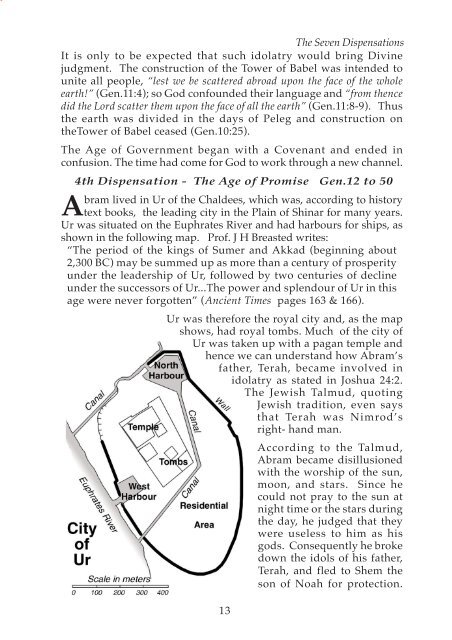The Basics of Bible - Herald of Hope
The Basics of Bible - Herald of Hope
The Basics of Bible - Herald of Hope
You also want an ePaper? Increase the reach of your titles
YUMPU automatically turns print PDFs into web optimized ePapers that Google loves.
<strong>The</strong> Seven Dispensations<br />
It is only to be expected that such idolatry would bring Divine<br />
judgment. <strong>The</strong> construction <strong>of</strong> the Tower <strong>of</strong> Babel was intended to<br />
unite all people, “lest we be scattered abroad upon the face <strong>of</strong> the whole<br />
earth!” (Gen.11:4); so God confounded their language and “from thence<br />
did the Lord scatter them upon the face <strong>of</strong> all the earth” (Gen.11:8-9). Thus<br />
the earth was divided in the days <strong>of</strong> Peleg and construction on<br />
theTower <strong>of</strong> Babel ceased (Gen.10:25).<br />
<strong>The</strong> Age <strong>of</strong> Government began with a Covenant and ended in<br />
confusion. <strong>The</strong> time had come for God to work through a new channel.<br />
4th Dispensation - <strong>The</strong> Age <strong>of</strong> Promise Gen.12 to 50<br />
Abram lived in Ur <strong>of</strong> the Chaldees, which was, according to history<br />
text books, the leading city in the Plain <strong>of</strong> Shinar for many years.<br />
Ur was situated on the Euphrates River and had harbours for ships, as<br />
shown in the following map. Pr<strong>of</strong>. J H Breasted writes:<br />
“<strong>The</strong> period <strong>of</strong> the kings <strong>of</strong> Sumer and Akkad (beginning about<br />
2,300 BC) may be summed up as more than a century <strong>of</strong> prosperity<br />
under the leadership <strong>of</strong> Ur, followed by two centuries <strong>of</strong> decline<br />
under the successors <strong>of</strong> Ur...<strong>The</strong> power and splendour <strong>of</strong> Ur in this<br />
age were never forgotten” (Ancient Times pages 163 & 166).<br />
Ur was therefore the royal city and, as the map<br />
shows, had royal tombs. Much <strong>of</strong> the city <strong>of</strong><br />
Ur was taken up with a pagan temple and<br />
hence we can understand how Abram’s<br />
father, Terah, became involved in<br />
idolatry as stated in Joshua 24:2.<br />
<strong>The</strong> Jewish Talmud, quoting<br />
Jewish tradition, even says<br />
that Terah was Nimrod’s<br />
right- hand man.<br />
According to the Talmud,<br />
Abram became disillusioned<br />
with the worship <strong>of</strong> the sun,<br />
moon, and stars. Since he<br />
could not pray to the sun at<br />
night time or the stars during<br />
the day, he judged that they<br />
were useless to him as his<br />
gods. Consequently he broke<br />
down the idols <strong>of</strong> his father,<br />
Terah, and fled to Shem the<br />
son <strong>of</strong> Noah for protection.<br />
13


